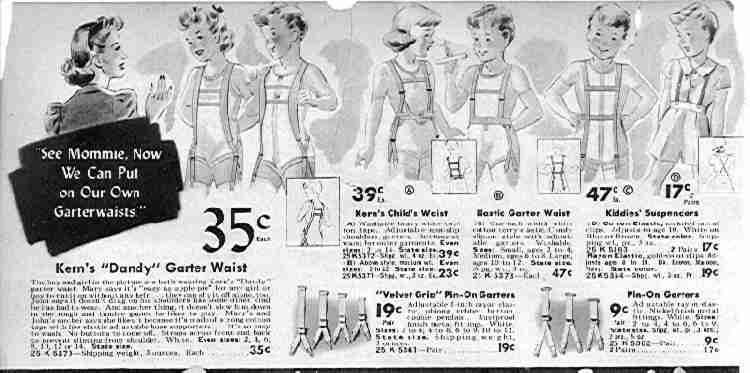1940
1941
Spring, 1941 -- Two of the same styles of garter waists as in the previous
Fall, but a different image--boys and girls both. Fall, 1941 -- the image with "Mommie" and the boy and girl boasting that they can put on their own garter waists without assistance. Several different styles with boy and girl models. A Ward's garter waist in the 1941 Fall/Winter catalog illustrates the overlap between underwaists and garter.
1942
Spring, 1942 -- children's garters and garter waists (p. 512)--both boys and
girls.
Fall, 1942 -- 3 different styles of garter waists--both genders.
1943
Spring, 1943 -- Kern's garter waist -- one style only (shoulder style with no waist band)--boy model
Fall, 1943 -- children's garter waists (a repeat of Spring, 1942)--both
genders.
.
1944
Spring, 1944 -- Long stockings still advertised but no individual hose
supporters or garter waists at all.
Fall, 1944 -- No hose supporters or garter waists advertised at all in this
catalog, although long stockings are still advertised (the image of the boy and girl sitting with the boy wearing an Eton collar--tan stockings extra long).
1945
Spring, 1945 -- No individual hose supporters or garter waists advertised
Long stockings available, however.
Fall, 1945 -- No individual hose supporters or garter waists advertised. Long
stockings still available.
Ages
The sizes for the stocking supporters were through age 12, and 14 in the case of one style. HBC notes that most of the available adds from comparable Sears catalogs were only for boys through age 10. Also while the advertisements picture boys and girls age 10-12 in long stockings, the stocking supporter advertisements only picture younger children.
Country Trends
All of our information on stocking supporters at this time is American. We have no indormation about stocking supporters in other countries. German sources tell us that most mothers adopted ad hoc devices such as saftey pins or rubber bands rather than store bought stoking supporters as shown here.
Rubber
This survey of the Sears catalogs from 1940 to 1945 is quite revealing. It
hadn't occurred to me before, but one reason, perhaps, for the rapid decline
of long stockings during World War II and afterwards was the scarcity of rubber, which was badly needed for the war effort. The Japanese after imobilizing the American Pacific fleet at Pearl Harbor seized of Malayia and Singapore (February 1942) and Burma from the British and the Dutch West Indies from the Dutch. This cut the Allies off from the bulk of the world's supply of rubber. As a result rubber as a critical war material was strictly rationed and a crash program to produce synthetic rubber was launched. Elastic before the War was made from natural rubber. To be effective hose supporters and some parts of garter waists needed to be stretchy. Elastic didn't disappear altogether of course. It was still used to produce adult products such as women's hose supporters and men's suspenders (basic necessities), but children's hose supporters were apparently considered less important. My guess is that mothers stopped insisting on supporters and long stockings for boys and girls when rubber became difficult to come by, although it is curious that boys continued to wear elastic suspenders for their trousers during the period of the shortage, and Sears didn't drop suspenders from their catalog pages in 1944 and 1945. But when garter waists reappeared in the Sears catalogs in the Fall of 1946 after the war was over, the ads became much less prominent than they had been in the period from the mid 1930s to 1943. Not only was the variety of models of garter waists reduced, but one of the two styles that kept reappearing for several years used only the barest minimum of elastic in the construction--a little elastic insert in supporters that were otherwise entirely made of non-elastic tape and therefore much less comfortable and effective as a means of holding up stockings. It would be interesting to know whether Wards also dropped garter waists and hose supporters during the years 1944 and 1945 for the same reason as Sears, but I have not been able to obtain Wards catalogs from the later 1940s. This may in time be possible, however. But this information does throw some interesting cultural light on long stockings in the 1940s. A HBC reader writes, "I myself don't recall any shortage of elastic or the difficulty of obtaining garter waists, but I stopped wearing them about 1941 when I was sent away to boarding school. The styles of course were changing, and perhaps boys didn't need garter waists when they switched to knickers (certainly not if they wore knee socks). But then knickers also were dying out in the later 1940s and replaced increasingly with long trousers. So the question is a tricky one. Did the shortage of elastic contribute to the demise of long stockings (which had to be worn with supporters), or was the style of wearing long stockings already dying out before the shortage reinforced the style change? Perhaps a bit of both."
HBC

Navigate the Historic Boys' Clothing Web Site related pages :
[Return to the Main U.S. stocking supporter chronology page]
[Return to the Main U.S. long stockings page]
[Return to the 1941 U.S. catalog page]
[Return to the 1943 U.S. catalog page]
[Knee socks]
[White knee socks]
[Long stockings]
[Striped socks]
[White stockings]
[Tights]
Navigate the Historic Boys' Clothing Web Site:
[Introduction]
[Activities]
[Biographies]
[Chronology]
[Cloth and textiles]
[Clothing styles]
[Countries]
[Topics]
[Bibliographies]
[Contributions]
[FAQs]
[Glossaries]
[Satellite sites]
[Tools]
[Boys' Clothing Home]
Created: January 10, 2000
Last updated: 12:59 AM 2/21/2006



